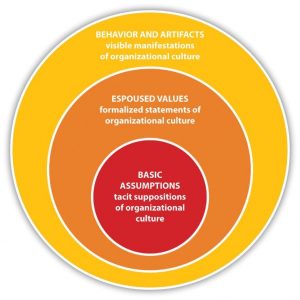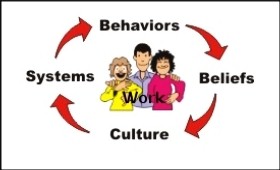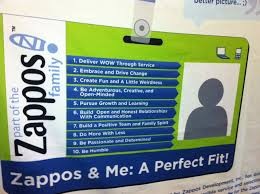Organizational culture is a system of shared traditions, values, and beliefs, which have a great effect on how people behave in organizations. Values are lasting beliefs which have a strong influence on the people in the organization. It dictates how the organization appears in public eyes. Edgar Henry Schein (born March 5, 1928), a former Professor at the MIT Sloan School of Management, is known for his work in the field of organizational development, more so in areas such as career development, talent management, group dynamics and cultural developments. Edgar Schein‘s model of organizational culture originated in the 1980s. Edgar Henry Schein identified three distinct levels in organizational cultures: artifacts and behaviors, espoused values and assumptions which came to be known as Edgar Schein’s three levels of organizational culture
Artefacts include any tangible, evident or verbally identifiable elements in an organization. These include the architecture, beautification of workplace, careful design, layout, fitting and maintenance, built-in space for movement (space, sound, and acoustics), functionality, attractive visuals, elegance, furniture etc. Artifacts include dress codes; explicit dress codes speak a lot about workplace culture. They are varied as workplaces are. It differs as per the nature of the workplace, it is the starting point of defining and determining a dress code. Wearing I-Card and clean dress, well-groomed employees speaks a lot about organizations.
The employees are organization’s first brand ambassadors. Law firms are different from IT firms, hospitals are different from hospitality, manufacturing is different from retail and back office work is different from client-facing work. Dress code, languages, selection of courteous language, office jokes, all exemplify organizational artifacts. Artifacts are the visible elements in a culture and they make the first impression on outsiders. Lazy, shabbily dressed, sloppy employees mar the image of the organization. When we meet gossiping, paying no heed to customers and lost in their old world employees, we lose interest in transacting with the organization. Don’t we?
Espoused values are the organization’s stated values and rules of behavior. It is how the members represent the organization both in terms of their behavior and the shared values. Their interpersonal behaviors and their behaviors with outsiders speak volumes. This is expressed in mission, vision, philosophies and values of the organization. The mission, vision, goals, values need to be displayed nicely in framed posters in strategic locations in organizations. They are official philosophies and statements of identity for the public. A company’s mission statement is essentially its statement of purpose.
It serves as a guide for all of the company’s decision-making. Shareholders, leaders and employees and customers are generally the target of the mission. It projects the future, of what the organizations hopes to become. Likewise, vision statements help to describe the organization’s purpose. Vision statements also include the organization values. Vision statements give direction for employee behavior and helps provide inspiration. They help in organizational analysis which is the process of reviewing the development, work environment, personnel and operation of a business or another type of association. In professional organizations you will see that espoused values are shared by employees at all levels. Trouble may arise if espoused values by leaders are not in line with the deeper implied assumptions of the culture.
The third level is Assumptions which are shared basic assumptions. These are deeply embedded, taken-for-granted behaviors which are usually unconscious, but constitute the deep essence of culture. These assumptions are well integrated in the work culture, that they are easily recognized in actions of the employees and management. The inner aspects of human nature constitute the third level of organization culture. The inner values of individual employees can make or break an organization. Being honest to work, being a well-wisher of the organization, putting in the extra bit matters a lot. Sometimes when employees need to put in late hours, and they refuse, or when female employees are dominated by male employees, or when females employees are harassed by their bosses it portrays the culture. The organizations follow certain practices, which are not discussed often but understood on their own. Such behaviors form the third level of the organization culture.
The three levels refer to the degree to which the different cultural phenomena are visible to the observer.
Aligning the three layers: Inside organizations, there may be different subcultures. Schein believes that the alignment between these three subcultures is critical for growth. Many problems that are attributed to bureaucracy, environmental factors or personality conflicts among managers are in fact the result of the lack of alignment between these factors of culture.
Organizations must use a broad-spectrum yet strict approach to educate its members of the organization’s values. Remember, values are important only when the organizations’ members have accept them. Organizations need to publicize them widely internally, so that it goes down well externally. For example, if an organization gives importance to educational qualifications of employees, the values should be explained in detail to the members as they pass through the organization’s education system.
The values must be demonstrated to the employees through the senior managers. They say ‘practice before your preach’ the seniors play a vital role in practicing the values of the organization. Douglas Macgregor states that highly successful organizations do not simply proclaim a set of values; rather they immerse their managers as well as their employees in the ideology to an obsessive degree. It is a certainty, that any disconnect between the behavior of the senior leaders and the values of the organization strongly undermine the commitment of the organization to those values in the minds of its members. And, the adherence of the members to the organization’s values is the core of discipline. Whatever that undermines values also undermines organizational discipline.
Also, when new employees enter the organization, they learn the values of the organization through their initial socialization processes with other members of the organization. Though, this fact is considered as informal method, it is quite powerful. The new employees can be molded in the system within first two weeks. Finally, all organizations are socio-technical systems in which the manner of external adaptation and the solution of internal integration problems are interdependent: employees, managers, investors, suppliers, the community, government and the customers shape an organization. The internal adaptation of an organization shapes the external adaptation.
Zappos.com is an online shoe and clothing shop currently based in Las Vegas, Nevada. In July 2009, the company announced it would be acquired by Amazon.com in an all-stock deal worth about $1.2 billion. Since its founding in 1999, it has become one of the world’s largest online shoe stores. Zappos has become almost as well known for its culture as it is for the shoes that it sells online. How does Zappos culture look like? It believes in delivering an experience of ‘WOW’ through service. The company believes in embracing change constantly. It believes in creating fun and weirdness among the employees. Weirdness is necessary for creating innovation. It encourages its employees to be adventurous, creative and open-minded and pursue learning. The organizations believes in building honest relationship with its employees with transparent communication. In true sense Zappos behaves like a close-knit family.
When it comes to hiring employees, it starts with a cultural fit interview, which carries half the weight of hiring the candidate. New employees are offered $2,000 to quit after the first week of training if they decide the job isn’t for them. Ten core values of the company are instilled in every team member. Employee raises come from workers who pass skills tests and exhibit increased capability, not from office politics. Portions of the budget are dedicated to employee team building and culture promotion. The organization passes on great benefits and a workplace that is fun and dedicated to making customers happy all fit in with the Zappos approach to company culture, where one gets the company culture right, great customer service and a great brand will happen on its own. Zappos has established what the company culture is, and fitting into that culture is the most important thing managers look before hiring.
















































